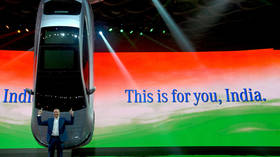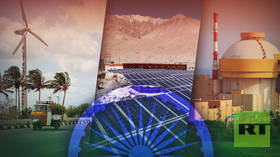Two world giants are vying to control this vital resource

Lithium, frequently dubbed “white gold,” is pivotal to modern industries and technology. Rechargeable lithium-based batteries are essential in storing solar and wind energy as well as in powering electric cars. Lithium-ion batteries, which have a long lifespan and excellent energy density, are also utilized to produce consumer electronics goods such as laptops and smartphones.
As the world shifts to cleaner, sustainable energy sources, the ease of access to lithium could potentially impact the efficiency and viability of various renewable energy projects in the future.
The swift rise in electric vehicle adoption is intensifying pressure on lithium mining. Demand for lithium is projected to grow more than fivefold by 2030. Currently, Australia and three Latin American countries – Chile, Argentina, and Bolivia, referred to as the “Lithium Triangle,” hold over 75% of the world’s lithium supply, which is then sent to China for processing.
Amid this worldwide scramble for critical minerals, India, still a minor player, is working to bolster its lithium supply chain by engaging with African nations, as well as via other strategies. Ensuring a reliable supply of raw lithium is crucial for electric vehicle (EV) production and supply chain security, and Africa’s potential could help position India as a leader in the global EV market.
India’s Lithium Journey
Lithium has become one of India’s most critical minerals; it is also classified as a “strategic mineral.” However, India doesn’t produce it domestically and relies entirely on imports. The recent discovery in February 2023 of 5.9 million tons of inferred lithium ore in the Salal-Haimna areas of Reasi district, Jammu & Kashmir, has significantly improved India’s lithium prospects.
This find could position India as the sixth-largest holder of lithium resources globally, ahead of China. This development is expected to impact India’s long- and medium-term lithium supply projections and help it navigate the current uncertainties related to the US-China competition over EV supply chain dominance.
In fact, this finding may contribute to India’s rise to prominence as a green industrial hub. In its quest to become a reliable supplier of lithium-ion batteries, India has been in competition with China for a while now.
This is being done in light of the possibility of exporting these batteries in the future and India’s recently upgraded ranking as the world’s third-largest vehicle market. If India succeeds, it might be able to export low-displacement motorbikes, scooters, and affordable farm equipment to other developing nations.
However, challenges remain. The lithium reserves that have been detected are situated roughly thirty miles away from the Line of Control, which divides Pakistan-occupied Kashmir from the Indian union territory of Jammu and Kashmir. India has to tackle the difficulty of harnessing a valuable resource from its most politically volatile region. Since 1947, the region has seen numerous conflicts and violent skirmishes erupt between India and Pakistan, often fueled by Pakistani separatists. In addition, the Reasi district is a hilly area with a fragile ecosystem. Furthermore, compared to reserves in Bolivia (21 million tons), Argentina (17 million tons), and Australia (6.3 million tons), India’s lithium finding is comparatively modest. Thus, even though the discovery would boost the nation’s green economy, it is inadequate.
Not surprisingly, given these diverse and demanding circumstances, India is also exploring lithium beyond its national borders.
Africa Quest
The Secretary of Mines, V.L. Kantha Rao, declared in March 2024 that India is looking to Africa to meet its critical mineral demands, especially Zambia, Namibia, the Democratic Republic of Congo (DRC), Ghana, and Mozambique.
Several African nations reportedly approached the Indian government earlier in 2022. They offered to give access to their vital mineral resources in exchange for repayment of a portion of their development loans. The specifics of these countries remain undisclosed, but obtaining access to African lithium would significantly advance India’s green industry growth.
Gaining access to African resources is crucial for India’s lithium industry development, but China’s dominance in this area presents a significant challenge.
Over the years, China has established a near-monopoly over several key mineral supply chains, including cobalt, lithium, and many rare earth metals. It controls most of the global lithium supply chain and is the leading refiner of lithium. Despite holding only a tiny fraction of the world’s lithium reserves—less than 7%, China produces most of the new energy vehicles sold. It is the largest importer, refiner, and consumer of lithium, handling 70% of global output and purchasing 70% of lithium compounds, mostly for its domestic battery manufacturing sector.
Since 2018, China, which relies on imports for about two-thirds of its raw materials, has been aggressively acquiring large lithium mines around the globe. In recent years, China has invested in mines in Zimbabwe, the Democratic Republic of the Congo, Argentina, Australia, and Canada. According to some forecasts, by 2025, mines under Chinese control are expected to produce 705,000 tons of battery-grade processed lithium, a significant increase from the 194,000 tons produced in 2022.
Way forward
India is at a pivotal point in developing its lithium industry. A thriving lithium sector could significantly boost the country’s economic prosperity. Consequently, India is prioritizing the development of its lithium supply chain to support future growth, lead the transition to renewable energy, and reduce strategic vulnerabilities. Nonetheless, the country’s dependence on imports from China and its fragile supply chain pose risks to the stability of its access to essential minerals.
Here lies the paradox: for India to advance in the lithium value chain, it must navigate its relationship with China more effectively.
China has long sought a stable supply of critical minerals like lithium through strategies such as the Belt and Road Initiative. While US and European officials focus on fostering cooperation with Africa and compiling lists of essential minerals, Chinese companies are actively on the ground, engaging in the ‘mineral cold war’ and capitalizing on Western indecisiveness by acquiring African mines and establishing domestic processing refineries.
India should collaborate with like-minded Global South countries to challenge China’s dominance. How New Delhi addresses its ‘China challenge’ in securing access to Africa’s lithium resources could shape its energy transition and establish the country as a leader in the Global South.
















